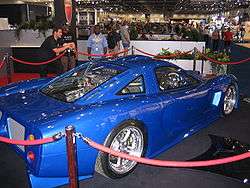Keating TKR
| Keating TKR | |
|---|---|
| Overview | |
| Manufacturer | Keating Supercars |
| Production | 2009–present |
| Assembly | UK |
| Body and chassis | |
| Body style | 2-seat Berlinetta |
| Layout | Mid-engine, rear-wheel drive |
| Powertrain | |
| Engine | 7L Twin turbocharged V8, 2002bhp |
| Transmission | 5-Speed manual |
| Dimensions | |
| Length | 4,413 millimetres (173.7 in) |
| Width | 1,900 millimetres (75 in) |
| Height | 1,145 millimetres (45.1 in) |
| Curb weight | 1,190 kilograms (2,620 lb) |
The Keating TKR [1] is a British sports car by Keating Supercars. It uses parts from the Saleen S7 and the Pagani Zonda. The company that produces it (Keating; formerly known as Barabus Sportscars Ltd) was founded by Tony Keating and is based in Bolton, Greater Manchester, England. The TKR features a twin turbo-charged 7.0L V8 petrol engine derived from the General Motors LS (LS7) series developing 2,002 hp (1,493 kW). According to Keating, it can accelerate from 0-60 in 2 seconds.[2]
The TKR has been recorded travelling at 260.1 mph[3][4] at the El Mirage Lake, California. In 2010 the TKR was set to be the car of choice to break the blind land speed record. Unfortunately, the car crashed on a test run and was unable to break this record.
Development
Barabus TKR
| Barabus TKR | |
|---|---|
| Overview | |
| Manufacturer |
|
| Powertrain | |
| Engine | 6.0 L V8 Bi-Turbo – 1005 HP |
| Chronology | |
| Successor | Keating TKR |

The idea for a car with the attributes of the Barabus TKR was born in 1996. The project was formed in the Italian town of Colonnella and included a plan to import the drive system from a factory in Great Britain.
Eventually, a prototype was placed on display at the 2006 British International Motor Show in London. The inaugural design of the car was inspired by the American Saleen S7 for its front section, and the Italian Pagani Zonda for its rear structure. At the time of its official release in mid-2006, the Barabus TKR was promoted as a supercar that could reach a top speed of 435 kilometres per hour (270 mph),[5] with the capacity to reach 60 miles per hour (97 km/h) from a stationary position in 2 seconds.[6]
The TKR uses an eight-cylinder engine with 6.0 litres (1.6 US gal) capacity and is equipped with two turbochargers. The engine produces 1005 horsepower, which classifies it among the most powerful production cars in the world, including the Bugatti Veyron 16.4, Bristol Fighter T, and SSC Ultimate Aero. The interior of the TKR is made from a combination of fine leather and suede, while the accents are provided by materials (such as brushed aluminium or carbon fiber) combined with painted highlights.[6]
- ↑ "Home". Keating Supercars. 2014-06-20. Retrieved 2018-08-30.
- ↑ Whitworth, Ben (2009-11-06). "Is Keating heading for the record books?". CAR Magazine. Retrieved 2018-08-30.
- ↑ "Keating TKR News And Reviews". Top Speed. Retrieved 2018-08-30.
- ↑ http://www.motorauthority.com/blog/1038101_keating-boasts-260-1-mph-top-speed-for-tkr-supercar
- ↑ Leftlane Staff (21 July 2006). "Barabus TKR takes over as world's fastest car?". leftlanenews.com. LEFT LANE NEWS. Retrieved 5 April 2012.
- 1 2 Simona (21 July 2006). "2007 Barabus TKR". topspeed.com. TopSpeed.com. Retrieved 5 April 2012.